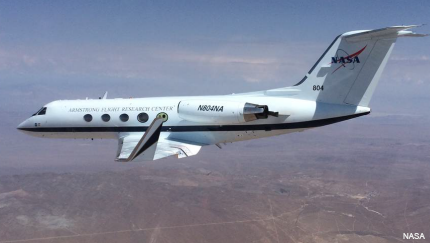Air Force, NASA test jet with 'morphing' wings
The technology promises to make aviation more fuel-efficient, environmentally friendly and quieter.

Flap angles were adjusted from -2 degrees to 30 degrees during testing.
Flying aircraft could be about to get cheaper, quieter and more environmentally friendly as a result of more than 15 years of research spearheaded by the Air Force Research Laboratory, with big assists from NASA and engineering company FlexSys.
A NASA team recently completed initial flight tests of a Gulfstream III jet with wings that “morph” in-flight, adjusting flap angles from -2 degrees up to 30 degrees. The technology, which could be retrofitted onto existing aircraft or built into new ones, could save millions of dollars in fuel costs each year, allow for lighter airframes and reduce the environmental footprint of any plane with morphing wings. It also would cut down on aircraft noise during takeoffs and landings, according to a NASA press release.
The test team at NASA’s Armstrong Flight Research Center in Edwards, Calif., has flown 22 research flights over the past six months using the wings, formally known as Adaptive Compliant Trailing Edge (ACTE) flight control surfaces. NASA said the tests hit their primary and secondary goals on schedule and within budget.
The flights are taking place under NASA’s Environmentally Responsible Aviation (ERA) program, but the research dates to an AFRL initiative in 1998, when Air Force researchers began working with FlexSys though the Small Business Innovative Research (SBIR) program. They developed several designs and tested them in wind tunnels through 2006. NASA came aboard in 2009, agreeing to fit ACTE flaps, designed and built by FlexSys, onto the Gulfstream as part of its ERA project.
“We are thrilled to have accomplished all of our flight test goals without encountering any significant technical issues,” Pete Flick, AFRL program manager from Wright-Patterson Air Force Base, Ohio, said in the release. “These flights cap 17 years of technology maturation, beginning with AFRL’s initial Phase 1 SBIR contract with FlexSys, and the technology now is ready to dramatically improve aircraft efficiency for the Air Force and the commercial aviation industry.”



